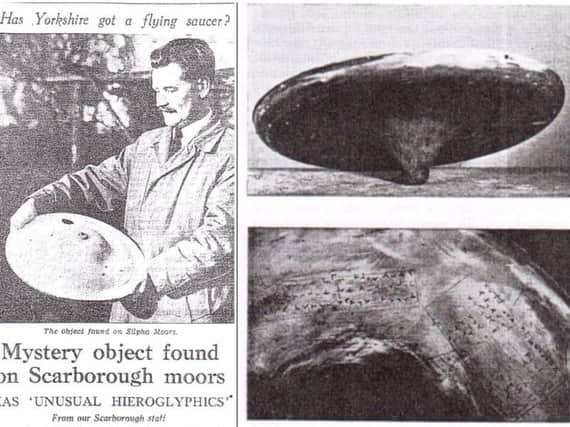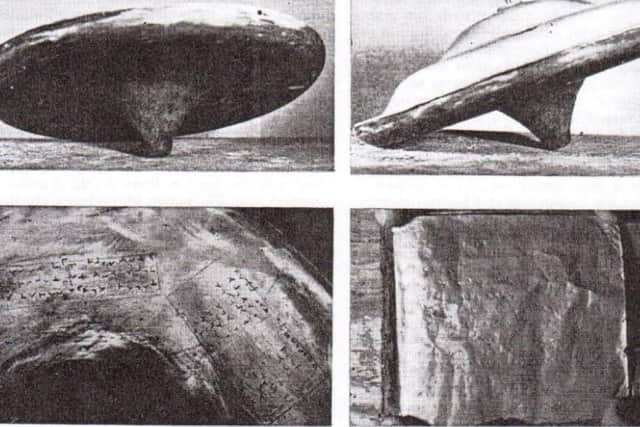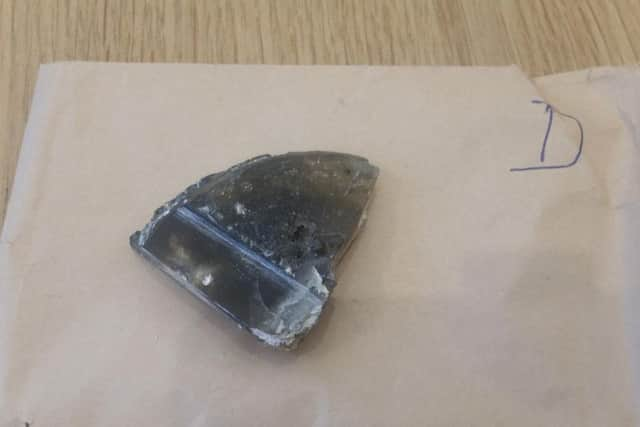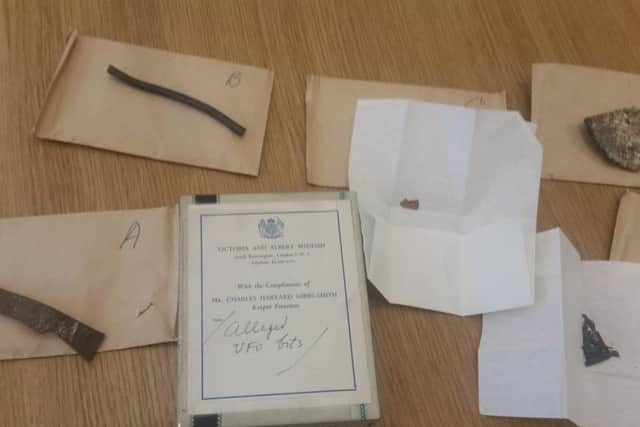Missing wreckage of UFO which 'crash landed' in Yorkshire is found, 60 years on


The story has been claimed by some experts as Britain’s answer to the Roswell incident.
The remaining parts of the Silpho UFO have now been found In a plot worthy of The X-Files the metal object, shaped like a flying saucer with hieroglyphics inscribed on its base, was found by three men on Silpho Moor, near Scarborough, one night in November 1957.
Advertisement
Hide AdAdvertisement
Hide AdOne later paid £10 – more than £200 in today’s money – for the mysterious object that appeared just weeks after the Russians launched Sputnik into orbit around Earth. But what became known as the Silpho Saucer vanished without trace soon after the finders cut it open in the town.


Photographs show the copper base of the object was inscribed with hieroglyphs that one of the men compared with Russian lettering.
Hieroglyphics were also found on the wreckage of the UFO that allegedly crashed at Roswell, New Mexico, in June 1947.
When the Yorkshire object was opened a tiny book made of 17 thin copper sheets was found inside, held in place by a coil of copper wire.
Advertisement
Hide AdAdvertisement
Hide AdThe sheets were covered in more hieroglyphics and these were deciphered by a Scarborough café owner, Philip Longbottom. He claimed they contained a bizarre 2,000-word message allegedly sent to Earth by an alien called Ullo who wanted to warn us about atomic warfare.


It contained the warning: ‘You will improve or disappear’. For decades afterwards UFO enthusiasts drew a blank in their quest for the missing saucer – although some claimed it ended up in a scrapyard or had been on display in a fish’n chip shop in Scarborough.
The Yorkshire Post broke the story in 1957. But for half a century the missing pieces of the puzzle have been sitting inside a tin cigarette box at the Science Museum Group’s archive, more than 200 miles away from the wild moorland where they were found at the height of the Cold War.
Papers in the museum archives reveal the remains of the ‘Silpho Moor Object’ were sent to London for examination by experts in 1963.
Advertisement
Hide AdAdvertisement
Hide AdThe specimens included a fused section of the metal and plastic from the outer casing, a length of hollow copper tubing and tiny pieces of foil from the booklet that was discovered inside.


The Science Museum passed them to Gordon Claringbull of the Natural History Museum, who specialised in meteorites and explosives. He said he could find ‘nothing unusual’ in the samples.
In a memo to the Science Museum, Claringbull said that he was ‘prepared to wager anything’ that the pieces of metal were made on Earth. Sceptics claimed the ‘saucer’ was made from a domestic hot water cylinder in a back-street garage and planted on the moor as an elaborate hoax.
Believers such as Air Chief Marshal Lord Dowding, who led the RAF during the Battle of Britain during WW2, revealed in 1959 that he had ‘actually held and examined’ the Silpho object.
Advertisement
Hide AdAdvertisement
Hide AdHe described it as a ‘a miniature pilot flying saucer’ - and was convinced it was a genuine artefact from space. Tests carried out at Manchester University revealed the object’s shell contained lead and the copper parts were of unusual high purity.


But a metallurgist concluded it could not have arrived on Earth from space as there was no evidence it had been exposed to high temperatures. UFO expert Jenny Randles, who read the report produced in Manchester, said she believes ‘it is the most costly and well organised hoax that has ever taken place in Britain.
"The hoaxers never seemed to gain from it and whoever had it built spent considerably more than the £10 the finders reportedly paid for it".
Andy Roberts, former editor of UFO Brigantia magazine, said the Silpho Saucer story was Britain’s answer to Roswell incident, in which a crashed ‘flying saucer’ was allegedly spirited away from a ranch in New Mexico in 1947.
Advertisement
Hide AdAdvertisement
Hide AdIn both Roswell and the Yorkshire incidents the wreckage was covered with strange hieroglyphics, that led the finders to believe the objects were from space.
‘This is an amazing breakthrough,’ he said. ‘It’s incredible to hear that all this time pieces of this mystery object have been sitting in a museum archive’.
The story first broke on 9 December 1957 when the Yorkshire Post revealed how ‘a mystery object’, shaped ‘like a large flattish spinning top’, 45cm in diameter and weighing 15kg, had been found on the moor north-west of the town two weeks earlier.


Scarborough businessman Frank Dickenson, then 42, claimed he and two friends were driving up Reasty Hill near the village of Silpho at night when his car stalled and they saw ‘a glowing object in the sky’ that appeared to fall to the ground on a ridge above Broxa Forest.
Advertisement
Hide AdAdvertisement
Hide AdMr Dickenson left the car, climbed a steep bank and found the metallic saucer lying in a patch of bracken. But as he returned along a footpath to alert his friends he passed a young couple walking towards the scene. When the three men returned to search the moors, the object was gone.
But he was so desperate to get it back he placed a classified advert in the Scarborough newspaper. This was answered by someone claiming to be the mystery man on the moor, who initially demanded £200 in cash. Mr Dickenson later handed over £10 in a night-time exchange for the metal object that was hidden in a sack.
He asked Scarborough solicitor Anthony Parker to examine it at his home at Scalby.
Parker told the Press he had advised Mr Dickenson to hand it to the Air Ministry and said: ‘I do not think it is a flying saucer and I do not believe such things come from outer space’.
Advertisement
Hide AdAdvertisement
Hide AdBut Mr Parker’s fascination grew after he, Mr Dickenson and Philip Longbottom prised open the two halves of the object.
Inside they found traces of ash, fused glass and the copper book ‘that had a coil of hollow tubing wrapped around it’.
The story made headlines just two months after the Cold War space race began with the launch of Sputnik. Some of those who examined the Yorkshire ‘whatnik’ initially feared it could have fallen from the spy satellite or was part of a bomb or wartime mine.
And in a bizarre twist, over thirty years later a cache of IRA guns and bomb-making equipment was found near the same patch of isolated moorland shortly before Prime Minister Margaret Thatcher was due to speak at the Conservative party conference in Scarborough.
Advertisement
Hide AdAdvertisement
Hide AdThe arms cache included Czech-made Semtex, a key component in bombs used by Irish terrorists. It was found by a man searching for compost in Broxa Forest, close to Silpho Moor, in March 1989 and sparked a huge security operation.